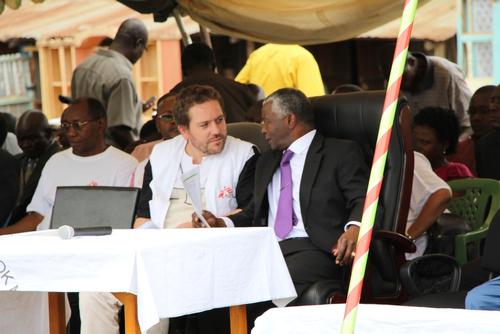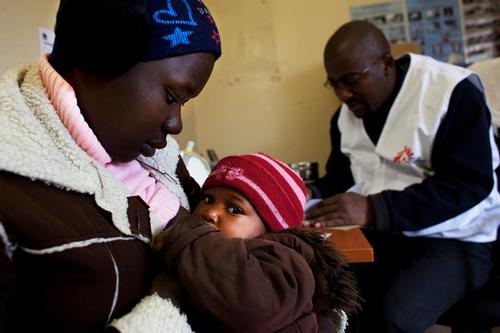In June 2014, MSF started a pilot project in Ndhiwa, a sub-county in western Kenya, aiming to curb the HIV epidemic there: one adult in four is HIV-positive and 2 in 100 get infected every year.
To tackle the epidemic, reduce the number of cases and their mortality, MSF intervenes to strengthen HIV activities at all level of the public health system, from the community to the hospital wards.
William Hennequin, MSF representative in Kenya, presents some of the project’s achievements and challenges.
Eighteen months into the project, have HIV care and treatment capacities increased?
We focused first on improving the standards of care and capacity in the 33 health facilities of Ndhiwa sub-county. They needed to cope with a planned increased in HIV patients, for two reasons: first, the change of protocols recommended by the World Health Organization in 2014, and second, MSF’s desire to undertake active screening campaigns.
To create the conditions necessary to address a major public health issue, MSF had to address very basic gaps at all levels of care. As a start, we ensured every health facility had the minimum standard of qualified health workers and logistics. When only one nurse is expected to run a broad range of activities (from general outpatient consultations to deliveries) and without the equipment and training to do so, you can’t expect him or her to complete tasks such as filling up HIV patient registers, provide counselling – or even perform full clinical examinations.
Therefore, MSF gave funds for the county to hire additional qualified staff (clinical officers, nurses, lab technicians among others). We also reduced their workload and improved their working environment, for example, by spacing patients’ appointments for routine follow-up from three to six months, and by creating ‘community AIDS groups’ where just one patient visits the centre, picking up drugs on behalf of other patients within their group as well.
We shifted several tasks to lay healthcare workers: HIV testing, adherence counselling, data verification and more. Some of these approaches had been successful in previous MSF HIV programs; this was the first time in Kenya.
Reducing the workload and providing additional training allowed health staff to focus on complex cases such as detecting and managing treatment failures.
Beyond that, we improved the working environment in health facilities: for example, filling gaps in some essential drugs, increasing access to some tests (CD4 count, viral load, TB); renovating some buildings and ensuring access to water and electricity for laboratory, data and pharmacy management.
Finally, teams are helping improving the data system, as the existing one could not provide crucial performance indicators such as the number of patients retained into care. This is a recurrent issue in HIV programs: how can the national HIV programs and their funding partners decide on what to improve when they rely on rather quantitative than qualitative indicators?
The project also aims to improve screening and diagnostic capacities. How? Our first goal is to encourage testing. We want to increase the number of people tested every year. The second goal is to treat patients as early as possible and retain them into care. Starting treatment earlier among the highest number of HIV positive people can reduce the virus’ transmission and reduce the number of individuals with a detectable viral load.
To achieve this, we implement community-based testing. (This might be further developed towards home-based testing.) The testers also act as mobilisers: we also provide Voluntary Medical Male Circumcision (VMMC).
Because of the intimate nature of this activity, we needed to ensure community acceptance and participation. We set-up Community Health Advisory Boards (CHABs) composed of representatives (teachers, religious leaders, chiefs and elders, youth and women representatives). They advise on the intervention strategy. They also help with communication and messaging, mobilising the community and more.
Testing and mobile VMMC activity started in April 2015. Results are mixed for now, notably in terms of attendance. However, we obtained better results in reaching men – who usually have poorer health seeking behaviours – compared to facility-based strategies.
MSF is also involved in hospital care. Why?
Improving inpatient clinical and nursing care is crucial to reduce HIV-related mortality. MSF teams support Ndhiwa hospital and the two adult medical wards of Homa Bay referral hospital. In the latter, MSF and Epicentre – our epidemiological branch – studied and gathered data on morbidities and mortalities. A worrying finding is that half the patients were HIV positive and 50% of those were already on ART treatment – and yet they were now admitted as AIDS patients with treatment failure.
This is further evidence of a lack of capacity to detect patients who are at risk of failing – and when detected, to follow up. The picture we have for both IPD and peripheral health facilities indicates a need for greater scaling-up, as well as improvements in all aspects of the HIV intervention.
What is the teams’ main challenge?
This is a pilot project – for Kenya and for MSF. It aims to be comprehensive and includes several different essential activities. It is quite a complex project. We are 6 to 9 months late compared to the original planning.
MSF teams can face uncomfortable situations: the quality of care is sometimes very low and improvements can be really slow. But if we want to create ownership and build capacities with our Kenyan partners and colleagues, we need to take the time to discuss and negotiate without imposing our approaches.
What are the next steps? We will continue to scale up the present intervention to diagnose as many HIV-positive people as possible – and enroll them into good quality care.
For instance, we will develop home based testing while supporting health facilities in giving patients care in a simplified and decentralised way. We will continue to focus on complex cases such as treatment failures, including hospitalised patients.
We will try to develop new avenues to target men and bring them into care. Approaches such as family model of care, couple testing and counselling should help us raise the number of adult and children being tested. We are also discussing the introduction of pre-exposure prophylaxis among at-risk groups.
In the hospital, now that the working environment has improved (additional staff, buffering of drugs, more space) we will work on a clearer medical strategy to reduce mortality to below 10% by 2017.
In January 2016 we will start a study in 20 health facilities in Ndhiwa to assess the HIV prevalence among infants aged 6 weeks to 6 months, as well as the quality and the timeliness of HIV care for this age group. This study will guide us in introducing enhanced HIV screening strategies for pregnant or breast-feeding women. It will also help improve the PMTCT program, and identify early the infected infants through point-of-care tests for Early Infant Diagnosis (EID) in the Sub-County.
Finally, in 2017, we will run another HIV prevalence and incidence survey to evaluate the impact of the program. Our aim is to create a sustainable model – and replicate it. These results might serve as a model for other high-burden counties in Kenya and inform its national HIV program.
Since the beginning of the project in Ndhiwa, MSF teams have participated in diagnosing some of the 5 000 HIV-positive people who didn’t know their status among Ndhiwa’s 240 000-strong population. They further supported close to 300 patients hospitalised in Homa Bay and Ndhiwa hospitals each month. They currently support authorities in providing treatment to almost 14 000 HIV-positive people in the sub-county.





